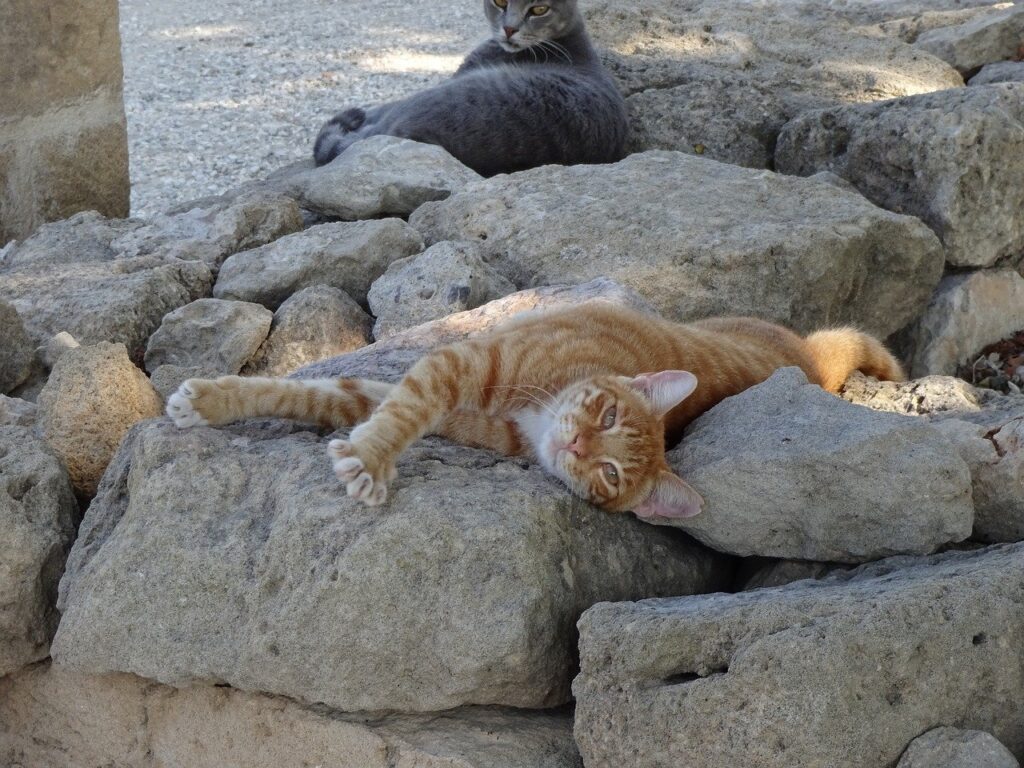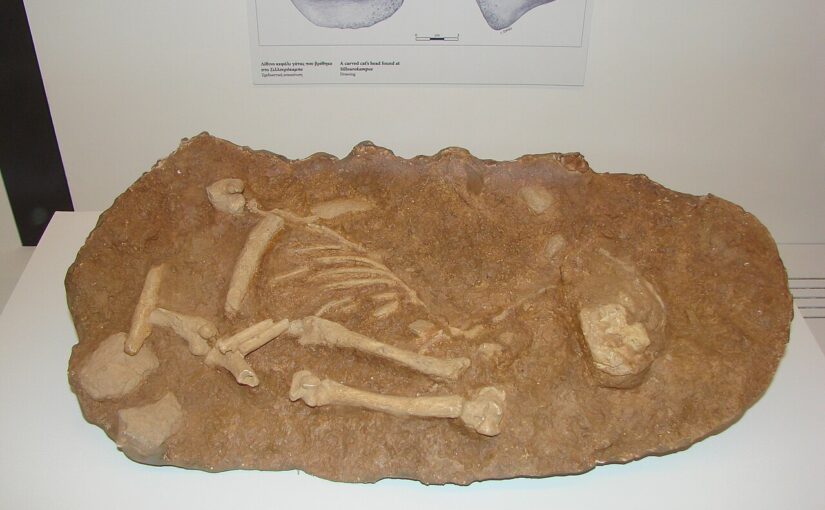For most of us, cats are beloved companions, mysterious characters who share our homes while retaining an air of independence. They curl on our laps, bat at dangling strings, and occasionally shoot us that inscrutable feline look that reminds us they are only half-tamed. Indeed, many experts believe that cats are never fully domesticated at all. Unlike dogs, whose ancestors lived in structured packs that humans could gradually take over by replacing the alpha, cats were solitary hunters who came to us on their own terms. Surprisingly, the friendship that grew from this unusual partnership may be far older than previously assumed. Recent discoveries on the island of Cyprus suggest that humans and cats have lived together in companionship for at least 9,500 years.
How Cats Became Our Neighbors
Around 12,000 years ago humanity changed profoundly. After countless generations of roaming as hunters and gatherers, people set down roots. They cultivated plants, domesticated livestock, and stored grain. This revolution began in the fertile lands stretching from the Nile Valley through the Levant and into Mesopotamia. It was here, in the so-called Fertile Crescent, that agriculture was born, and alongside it, a deepening relationship with animals.
The shift to agriculture brought abundance but also introduced a new menace: rodents. Granaries filled with stored grain were irresistible to mice and rats. Farmers defended their hard-earned harvests desperately, but they had a natural ally waiting in the wings. The African wildcat, adept hunters of small prey, began haunting the edges of these early settlements. To them, the granaries were an endless buffet of mice.
Humans quickly discovered the benefit of this partnership. Cats kept rodent populations in check, and in return they enjoyed a safe hunting ground and, most likely, scraps of food or warmth near the human hearth. This was not domestication in the strict sense; the cats had not been bred for specific traits, nor forced into a controlled environment. Instead, they adapted to human life on their own initiative. They chose us, in other words, rather than the other way around. And with that choice, a friendship between species was born.
Wanderers by Nature, Yet Drawn to People
Despite their notorious independence, cats seem curiously inclined to wander into our lives. Even the gentlest housecat retains a streak of wanderlust, gazing out of windows with longing, slipping out to explore gardens, alleys, or neighboring houses. Historically, this instinct led cats far beyond the edges of the Fertile Crescent.
Cats embraced the high seas long before the era of commercial airlines carried pets across continents. Although it is often said that cats dislike water, they proved themselves excellent companions for sailors. On ships, they performed their classic duty: hunting rats. By catching the rodents that gnawed on ropes, spoiled food supplies, or even competed with humans for something to eat, cats earned their keep many times over. Sailors entertained them with makeshift toys fashioned from musket balls and string, while some even built tiny hammocks for their feline shipmates. Cats required little fresh water, did not suffer from vitamin deficiencies like humans prone to scurvy, and adapted surprisingly well to life aboard ships. Over time, sailors came to see them not only as practical allies but as sources of comfort, good luck, and companionship during long voyages. Nautical tradition remains steeped in “cat language” even today, from knots called “cat’s paw” to the “catwalks” along a deck.
It may well have been such sea journeys that brought cats to Cyprus thousands of years ago. And there, archaeologists stumbled upon a discovery that would rewrite the timeline of our shared history.
A Burial That Changed the Story
In the Neolithic village of Shillourokambos on Cyprus, French archaeologists uncovered an extraordinary grave. Dating back around 9,500 years, the burial belonged to a young individual of high status, accompanied by polished stones, shells, tools, and ornaments. Yet the true surprise lay just 40 centimeters away from the human skeleton. There, carefully arranged, lay the remains of a young cat.
This was no ordinary wildcat corpse discarded by chance. The cat, around eight months old at death, showed no marks of slaughter. Instead, the evidence suggests that the animal was purposefully interred alongside the human. Both were buried facing west, a shared orientation that hints at ceremonial meaning. Archaeologists believe the cat may even have been intentionally killed in order to accompany its human companion into the afterlife.
This discovery was groundbreaking. Until then, scholars assumed that cats had first been domesticated in Egypt around 4,000 years ago. The Egyptians certainly adored their cats, deifying them, mummifying them, and breeding them in abundance. Yet the burial in Cyprus pushes the bond between cats and humans back another 5,000 years. It shows that even millennia before Egyptian temples echoed with the hymns of Bastet, cats were already woven into human life in a bond more spiritual than merely practical.
More Than Pest Control
The Cyprus burial also highlights a fascinating distinction in how humans relate to animals. Many species were domesticated primarily for their usefulness as food, transport, or labor. Dogs offered their strength and loyalty in hunting and guarding, while sheep and cattle provided wool, milk, and meat. Cats, however, could never be forced in the same way. They are not herd animals to be corralled, nor beasts of burden to be harnessed. They came close to us because it suited them. And humans, instead of harnessing them for labor, welcomed them for their talents and companionship.
This explains why cats are sometimes described as “semi-domesticated.” Most domestic cats today could survive if left to their own devices, unlike cows or sheep. Yet despite their independence, they have remained by our side for nearly 10,000 years. The Shillourokambos grave is a poignant reminder that our ancestors did not view cats simply as utilitarian mouse-catchers. They felt an emotional bond, one strong enough to inspire ritual respect in death.
Cats as Global Travelers
The discovery on Cyprus also tells another story: cats were world travelers from the very beginning. The island had no native feline population. This means humans deliberately transported cats by boat, centuries before large-scale navigation was common. To bring a cat onto an island required trust that it could be managed, cared for, and integrated into daily life. In that decision lies some of the earliest evidence that people truly valued the companionship of cats, not just their hunting skill.
Over the centuries, cats expanded across Europe, Asia, and beyond, sailing with Phoenician traders, Roman legions, Viking raiders, and later across oceans with explorers and colonists. Where we went, they went, and in return they guarded our food stores, offered amusement, and, perhaps most importantly, shared their quiet company during uncertain journeys.

A Friendship Written in Time
Today, when a cat curls into a ball on a family sofa, or flicks its tail against a reader’s leg, it continues a story begun thousands of years ago. The bond between humans and cats was not forged by force or breeding, but through a mutual recognition of benefit and comfort. For humans, cats were guardians against rodents, symbols of status, and ultimately affectionate companions. For cats, human settlements offered safety, shelter, and sustenance.
The burial on Cyprus serves as a testament that this relationship was already profound almost 10,000 years ago. It compels us to rethink the way we perceive domestication and companionship. While the Egyptians may have given cats their divine status, it seems that ordinary Neolithic villagers were among the first to love and honor the animal that would become one of humanity’s most cherished friends.
The Cat Who Chose Us
Cats have always been creatures of choice. From the African wildcat prowling ancient grain stores to the ship cats of the Age of Exploration, they decided to live alongside us, not the other way around. The grave in Shillourokambos whispers across millennia that this choice was not only practical but emotional. Humans and cats shared their lives, and even their deaths, far earlier than we imagined.
So when your cat gazes at you with those half-lidded eyes, aloof yet affectionate, remember this: you are part of a partnership nearly 10,000 years old. It is a friendship that began when a lone hunter stepped out of the night to linger near a human fire, and it continues every time you scratch a chin, provide a meal, or simply sit quietly while a soft purr fills the room.
Image: Cast of a cat burial dating to 7500-7000 B.C., unearthed at the site Parekklisia-Sillourokampos, Cyprus, indicating that domesticated cats were introduced to Cyprus from the Levant by boat. Limassol Archeological Museum. Catlemur.
If you find joy in these tales of twitching whiskers and gleaming eyes, consider helping keep Whiskerito.com alive and purring. Your donation supports thoughtful research, engaging content, and the warm, wonder-filled community that makes this space what it is.
